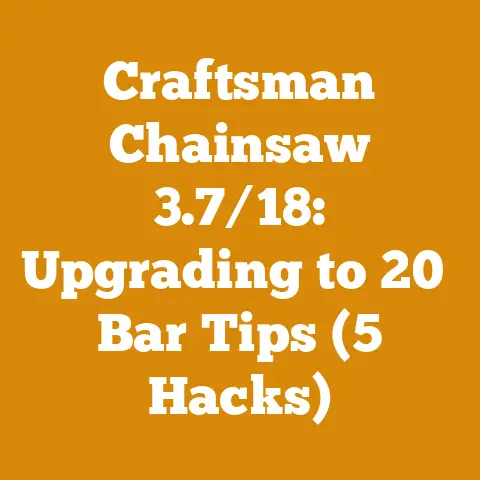Husqvarna K970 Concrete Chainsaw Tips (5 Pro Repair Hacks)
Ever wonder what the difference is between a perfectly cut concrete slab and one that looks like it was attacked by a badger? The answer often lies in the tools we use and how well we maintain them. Today, I’m diving deep into the world of concrete cutting, specifically focusing on the Husqvarna K970 concrete chainsaw – a true workhorse on any job site. But like any piece of machinery, it needs some TLC to keep it running smoothly.
I’ve spent years in and around construction sites, and I’ve seen firsthand how a well-maintained K970 can make or break a project. I remember one particularly grueling job cutting reinforced concrete for a building renovation. The team was using a different concrete saw, and it was constantly breaking down. The dust was awful, the vibrations were intense, and progress was slow. Finally, the foreman brought out his personal K970, and the difference was night and day. The cuts were cleaner, the dust was minimized thanks to the water cooling system, and the job got done much faster. That experience cemented my respect for this machine and the importance of keeping it in top condition.
Now, let’s get to the nitty-gritty. I’m going to share my top five pro repair hacks for the Husqvarna K970 concrete chainsaw. These aren’t just random tips; they’re based on real-world experience and a deep understanding of how this saw works. So, grab your toolbox, and let’s get started!
Husqvarna K970 Concrete Chainsaw Tips (5 Pro Repair Hacks)
I’m going to walk you through the common issues I’ve encountered and the solutions I’ve found most effective. These hacks will help you keep your K970 running like a champ, saving you time, money, and a whole lot of frustration.
1. Diagnosing and Fixing Starting Problems
One of the most common complaints I hear about the K970 is difficulty starting. This can be incredibly frustrating, especially when you’re on a tight deadline. Let’s break down the most likely culprits and how to address them.
-
The Fuel System:
- The Problem: Stale fuel, a clogged fuel filter, or a malfunctioning carburetor are often the root cause of starting issues. Ethanol-blended fuels are notorious for absorbing moisture and causing problems in small engines.
- My Solution:
- Fuel Quality: Always use fresh, high-quality fuel with a stabilizer, especially if the saw will be stored for extended periods. I recommend using fuel with an octane rating of 89 or higher.
- Fuel Filter: Replace the fuel filter every 50 hours of operation or at least once a season. It’s a cheap part, and a clogged filter can starve the engine of fuel.
- Carburetor: If the saw still won’t start after addressing the fuel and filter, the carburetor may need cleaning or rebuilding. I’ve found that using a carburetor cleaner spray can sometimes dislodge debris. However, for stubborn clogs, a complete carburetor rebuild kit is the way to go. The kit includes new gaskets, needles, and seats, ensuring a proper fuel-air mixture. A rebuild is a bit more involved, but the results are worth it.
- Pro Tip: When storing your K970 for the winter, drain the fuel tank completely. This prevents the fuel from gumming up the carburetor and causing starting problems in the spring.
-
The Ignition System:
- The Problem: A faulty spark plug or ignition coil can prevent the engine from firing.
- My Solution:
- Spark Plug: Check the spark plug for fouling or damage. A fouled plug will be black and oily, while a damaged plug may have a cracked insulator. Clean the plug with a wire brush or replace it altogether. The correct spark plug gap for the K970 is typically around 0.020 inches (0.5 mm).
- Ignition Coil: If the spark plug is good, but the saw still won’t start, the ignition coil may be the issue. Use a spark tester to check for spark. If there’s no spark, the coil needs to be replaced.
- Pro Tip: Always use the recommended spark plug type for your K970. Using the wrong plug can damage the engine.
-
Compression Issues:
- The Problem: Low compression can also prevent the engine from starting. This can be caused by worn piston rings or a damaged cylinder.
- My Solution:
- Compression Test: Use a compression tester to check the engine’s compression. A healthy K970 should have a compression reading of at least 100 PSI. Always use the correct fuel-oil mixture and avoid running the engine at excessively high RPMs for extended periods.
2. Maintaining the Cutting Chain and Bar
The cutting chain and bar are the heart of the K970. Keeping them in good condition is essential for efficient cutting and safety.
-
Chain Sharpening:
- The Problem: A dull chain will cause the saw to cut slowly and unevenly. It will also put more strain on the engine and increase the risk of kickback.
- My Solution:
- Regular Sharpening: Sharpen the chain every few hours of operation, or whenever you notice it’s not cutting as well as it should. I prefer using a chainsaw file and guide to ensure consistent sharpening angles.
- Proper Filing Angle: The correct filing angle for the K970 chain is typically around 30 degrees. Consult your owner’s manual for the specific angle for your chain type.
- Depth Gauges: Check the depth gauges (rakers) regularly and file them down as needed. If the depth gauges are too high, the chain won’t cut effectively.
- Pro Tip: Invest in a good quality chainsaw file and guide. It will make sharpening much easier and more accurate.
-
Bar Maintenance:
- The Problem: A worn or damaged bar can cause the chain to bind or derail.
- My Solution:
- Regular Inspection: Inspect the bar regularly for wear and damage. Look for burrs, grooves, or uneven wear.
- Bar Dressing: Use a bar dressing tool to remove burrs and smooth out the edges of the bar. This will help the chain run smoothly and prevent premature wear.
- Bar Rail Squareness: Ensure the bar rails are square. Use a bar rail gauge to check for squareness. If the rails are not square, the chain will cut unevenly.
- Grease the Sprocket: Keep the sprocket on the bar tip well-greased. This reduces friction and extends the life of the bar.
- Pro Tip: Flip the bar over periodically to distribute wear evenly.
-
Chain Tension:
- The Problem: Improper chain tension can lead to chain derailment, excessive wear, or even damage to the saw.
- My Solution:
- Proper Tension: The chain should be snug against the bar but still able to be pulled around by hand.
- Regular Adjustment: Check the chain tension frequently, especially when the chain is new. New chains tend to stretch more initially.
- Pro Tip: Always adjust the chain tension with the engine off and the bar cool.
3. Cooling System Maintenance
The K970 relies on a water cooling system to prevent overheating. Maintaining this system is crucial for the saw’s longevity.
-
Water Supply:
- The Problem: Insufficient water flow can cause the engine to overheat and seize.
- My Solution:
- Adequate Water Source: Always use a clean and reliable water source. A garden hose with good pressure is ideal.
- Water Flow Adjustment: Adjust the water flow to provide adequate cooling without excessive spraying.
- Water Filter: Install a water filter to prevent debris from clogging the water lines.
- Pro Tip: In cold weather, add antifreeze to the water to prevent freezing and damage to the cooling system.
-
Water Lines and Nozzles:
- The Problem: Clogged or damaged water lines and nozzles can restrict water flow and cause overheating.
- My Solution:
- Regular Inspection: Inspect the water lines and nozzles regularly for clogs or damage.
- Cleaning: Clean the water lines and nozzles with compressed air or a small wire.
- Replacement: Replace damaged water lines or nozzles as needed.
- Pro Tip: Use a descaling solution to remove mineral deposits from the water lines and nozzles.
-
Cylinder Fins:
- The Problem: Dust and debris can accumulate on the cylinder fins, reducing their ability to dissipate heat.
- My Solution:
- Regular Cleaning: Clean the cylinder fins regularly with compressed air or a brush.
- Proper Ventilation: Ensure the engine has adequate ventilation to prevent overheating.
- Pro Tip: Avoid running the engine in enclosed spaces without proper ventilation.
4. Air Filter Maintenance
A clean air filter is essential for proper engine performance and longevity.
- The Problem: A clogged air filter restricts airflow to the engine, causing it to run rich and lose power. It can also lead to premature engine wear.
- My Solution:
- Regular Cleaning: Clean the air filter every few hours of operation, or more frequently in dusty conditions.
- Cleaning Methods:
- Compressed Air: Blow out the air filter with compressed air from the inside out.
- Washing: Wash the air filter with warm soapy water. Rinse thoroughly and allow it to dry completely before reinstalling.
- Replacement: Replace the air filter every 50 hours of operation, or sooner if it’s damaged or excessively dirty.
- Pro Tip: Use a pre-filter to extend the life of the air filter. A pre-filter is a foam sleeve that fits over the air filter and traps larger particles of dust and debris.
5. Recoil Starter Repair
The recoil starter is a common point of failure on the K970.
- The Problem: The starter rope can break, the recoil spring can fail, or the pawls can wear out.
- My Solution:
- Rope Replacement: If the starter rope breaks, replace it with a new rope of the correct diameter and length.
- Spring Replacement: If the recoil spring fails, replace it with a new spring. Be careful when handling the spring, as it’s under tension and can cause injury.
- Pawl Replacement: If the pawls are worn out, replace them with new pawls. The pawls are the small levers that engage the flywheel when you pull the starter rope.
- Pro Tip: Lubricate the recoil starter mechanism with a light oil to keep it working smoothly.
Bonus Tip: Understanding the Cutting Depth Capabilities
The Husqvarna K970 concrete chainsaw isn’t a one-size-fits-all tool. Its cutting depth capabilities depend on the bar length and the type of material you’re cutting. I’ve found that knowing the limitations of your saw prevents unnecessary strain and potential damage.
- Bar Length and Cutting Depth: A longer bar allows for deeper cuts, but it also requires more power and can be more difficult to control. The K970 typically accommodates bars ranging from 12 to 16 inches. A 12-inch bar will give you a cutting depth of around 4-5 inches, while a 16-inch bar can cut up to 6-7 inches.
- Material Density: Denser materials like heavily reinforced concrete will require more power and a slower cutting speed. Trying to force the saw through dense materials can overheat the engine and damage the chain. Softer materials like asphalt are easier to cut and allow for faster progress.
- Cutting Technique: Using the correct cutting technique can also improve efficiency and prevent damage. Avoid plunging the saw straight into the material. Instead, use a sweeping motion to gradually increase the cutting depth. This reduces the risk of binding and kickback.
Safety First: The Importance of Personal Protective Equipment (PPE)
I can’t stress enough how important it is to wear the right PPE when operating a concrete chainsaw. Concrete dust contains silica, which can cause serious lung problems if inhaled. The saw also generates a lot of noise, and there’s always the risk of flying debris.
- Respirator: A properly fitted N95 or P100 respirator is essential to protect your lungs from concrete dust.
- Eye Protection: Wear safety glasses or a face shield to protect your eyes from flying debris.
- Hearing Protection: Use earplugs or earmuffs to protect your hearing from the loud noise of the saw.
- Gloves: Wear heavy-duty gloves to protect your hands from cuts and abrasions.
- Steel-Toed Boots: Wear steel-toed boots to protect your feet from falling objects.
- High-Visibility Clothing: Wear high-visibility clothing to ensure you’re seen by other workers on the job site.
Real-World Case Study: Saving a Historic Building
I was once involved in a project to renovate a historic building in my town. The building had thick concrete walls that needed to be modified to accommodate new windows and doors. The contractor initially planned to use jackhammers to break out the concrete, but I convinced them to try a Husqvarna K970.
We used a K970 with a 14-inch bar to make precise cuts in the concrete walls. The saw allowed us to remove sections of concrete without damaging the surrounding structure. The water cooling system minimized dust, and the vibration was significantly less than with a jackhammer.
The K970 not only saved time and money but also helped preserve the integrity of the historic building. The contractor was so impressed with the saw that they purchased one for future projects.
The Global Perspective: Challenges and Solutions for Small Operations
I understand that not everyone has access to the latest and greatest equipment or the resources to hire a professional mechanic.
- Limited Access to Parts: In some regions, it can be difficult to find replacement parts for the K970. One solution is to stock up on common wear items like spark plugs, air filters, and fuel filters.
- Lack of Skilled Mechanics: If you don’t have access to a skilled mechanic, it’s important to learn basic repair skills yourself. There are many online resources and tutorials that can help.
- Budget Constraints: When money is tight, it’s tempting to cut corners on maintenance. However, neglecting maintenance can lead to costly repairs down the road. Prioritize essential maintenance tasks like cleaning the air filter and sharpening the chain.
Conclusion: Mastering the K970 for Success
The Husqvarna K970 concrete chainsaw is a powerful and versatile tool that can make your concrete cutting projects faster, easier, and more efficient. By following these five pro repair hacks, you can keep your K970 running smoothly for years to come. Remember to prioritize safety, use the right PPE, and never underestimate the importance of regular maintenance.
I hope these tips have been helpful. Now, get out there and put your K970 to work! And remember, a little bit of maintenance goes a long way. It’s like they say, “An ounce of prevention is worth a pound of cure.” Happy cutting!






